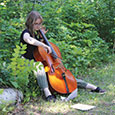I recently purchased a $3.99 analog battery operated clock. It has an overly-large face complete with second, minute, and hour hands. My husband and I agreed that it reminds us of the classroom clocks from our elementary school days. I placed it on a shelf in my flute room so I could glance at it while teaching. During a lesson I periodically look at the clock. I divide lessons into 20-minute chunks and knowing which quadrant of an hour we are in helps keep me on track with the curriculum. Usually, the first chunk of 20-minutes is spent on warming-up and fundamentals, the second on etudes, and the third on solo and excerpt repertoire.
My first student arrived for her lesson ready to work on several excerpts for an upcoming audition. Her first excerpt was the Scherzo from A Midsummer Night’s Dream, Op. 61 by Felix Mendelssohn. The excerpt, which begins a measure and a pick-up before Rehearsal P, is the final 47 measures of the movement. The Scherzo (3/8 meter, G Minor) is marked Allegro vivace and is conducted in one. While there is no metronome marking in the score, the generally accepted tempo is a dotted-quarter = 88. My student began the excerpt. She had done her homework and was playing well. However, the longer she played, the slower she got. She stopped and said, “It’s the clock. The tick is so loud that I think it is a metronome and I want to play with it.” I removed the clock from the flute room and put it downstairs on a shelf in the laundry room. We then finished the lesson without the distraction of the loud-ticking clock.
Laundry Room Practice
I have always practiced in the laundry room partly because it is secluded from my family and partly because I can do laundry while practicing. My first Taffanel & Gaubert 17 Big Daily Exercises routine, conceived in 1983, was based on the time it takes to wash a load of laundry (25 minutes). My objective was to get through the T & G exercises by the time I needed to switch the laundry from the washer to the dryer. I did not know at the time that neuroscientists would later suggest that practicing for 25 minutes and taking a short break (stretching) before practicing again would achieve the best results.
When I first began this routine, I could not always get through everything in 25 minutes. However, once I could reliably complete the routine in the allotted time, my technique was set. You may wonder if I ever practiced anything slowly. The answer is yes, but most of my slow practice was done when working with students. Exercises such as finding the ring in the sound, seamless slurs, and tone-color studies were repeated many times during my teaching day. With as many students as I taught at that time (45-60), I logged a lot of time playing slow exercises. When I was alone, I needed to play fast to lighten my fingers and keep my technique where it should be.
Back to the Clock
After the student’s lesson was over, I went down to the laundry room to begin my daily practice. I loaded the washing machine, sat down, arranged my music and music stand, and looked up. There was THE clock noisily ticking away. It was not long before I realized that I had left my favorite metronome (the one with the dictatorial voice) upstairs. My next thought was that I could use the ticking of the clock like a metronome because so many of the exercises I regularly practice are set with the metronome on 60 beats per minute. I began my practice watching the second hand of the clock count off second by second like a metronome. I soon realized I had a visual image to go along with the aural sensation of the ticking.
Measured Vibrato
Several times a week I like to practice measured vibrato on a few chosen notes throughout the range of the flute. I alternate placing four, five, or six vibrato cycles to each tick of the metronome set at 60. As I began to play this exercise in front of the clock, a couple of things happened. First, I thought the initiation of my vibrato cycle and subsequent flow was better because I could see the energy of the second hand as it moved around the face of the clock from one minute to the next. Second, it was easy for me to play this exercise for 20 seconds right off the bat, and soon 30 seconds was easy too. I have a small lung capacity (3 liters) so long notes have always a struggle. I have to admit long notes can be a struggle for me partly because my tone production sometimes borders on being too high maintenance, but that day the long vibrato notes were easy, ringing, in tune, and 30 seconds long.
Double Tonguing
Next I progressed to double tonguing practice. I usually practice sixteen counts of four sixteenths, double tongued on a B6 and then rest for two counts before repeating the drill. With the new clock practice aid, I practiced eight sixteenths instead of the usual four sixteenths to each second that the second hand marked off. Once again the flow and line of the rapidly tongued notes was greatly improved just from watching the sweep of the second hand going from one minute to the next. My inexpensive clock purchase was certainly paying off.
Round of Trills
Another favorite exercise of mine is called A Round of Trills. This exercise begins with the flutist trilling an F to a G chunk in the second octave for ¾ of a beat followed by a rest with the metronome set at 60. The idea is to get a good initiation of the finger movement and then a continuous fast movement throughout the trill. Trills sometimes seem to cycle in speed, first fast, then a moment of slower movements, followed by the fast speed. To correct this cycling, a flutist should find the distinctive position of the hand so the trill is even and effortless. The finger movement should come from the third knuckle back from the nail except in the case of the left index finger which is balancing the flute on that knuckle. After trilling a chunk from F5 to G5 eight or more times, I trill from G5 to A5 eight times. Finally, I alternate trilling the F5 to G5 chunk followed by the G5 to A5 chunk.
The F finger on the right hand is a strong finger because it is the index finger. However, the G finger (or ring finger) on the left hand is weak. Alternating these trills from a strong finger to a weaker finger helps the weaker finger to trill as well as the stronger finger. As I practiced this trill exercise with the loud-ticking clock, I again achieved a better result than usual. With each movement of the second hand, I trilled, rested, and prepared for the next entrance.
Scales
Each day I always begin playing the T & G No. 4 Tone Color Scales in chunks of eight notes followed by a rest. Some days I slur the eight notes; other days I double tongue them. I usually set the metronome on a marking between 60 and 80 and try to play all eight notes in one-half of the beat. Of course as the metronome numbers rise, it is easier to slur the notes than tongue them. The idea is to play a group of notes quickly on one puff of air. Even though when I practiced this exercise with my loud-ticking clock, I could only do the exercise at the equivalent of a metronome marking of 60, the benefits were so good that I would recommend trying this. I found the quality of the movement of the fingers on the scale was excellent when I associated this exercise with the visual image of the sweeping second hand.
Visual vs Aural Learner
Teachers know that some students are more visual while others are more aural. Often a student will tell you which they are if you listen for it. For example, if you explain something to a student and he replies, “I see, I see,” you can probably conclude that he is at least partially a visual learner. On the other hand if you play a passage for a student, and he plays it back to you right away rather than saying anything, he may be an aural learner.
The metronome is an invaluable aid, but an inexpensive, analog clock may be a useful addition to your teaching and practicing tools. Make sure that the second hand is prominent and that the clock has a loud tick. I found that this has really improved my practicing.
***
Laundry Routine
Taffanel & Gaubert 17 Big Daily Exercises
Monday
Daily Exercise No. 1,
No. 4 (Scale Game)
No. 5
No. 6 (Flat Keys)
No. 7
No. 8 (Key of the Day)
No. 10
No. 17
Tuesday
Daily Exercise No. 2
No. 4 (Scale Game)
No. 5
No. 6 (Sharp Keys)
No. 7
No. 9 (Key of the Day)
No. 11
No. 17
Wednesday
Daily Exercise No. 1
No. 4 (Scale Game)
No. 5
No. 6 (Flat Keys)
No. 7
No. 8 (Key of the Day)
No. 12
No. 17
Thursday
Daily Exercise No. 2
No. 4 (Scale Game)
No. 5
No. 6 (Sharp Keys)
No. 7
No. 9 (Key of the Day)
No. 13
No. 17
Friday
Daily Exercise No. 1
No. 4 (Scale Game)
No. 5
No. 6 (Flat Keys)
No. 7
No. 8 (Key of the Day)
No. 14
No. 17
Saturday
Daily Exercise No. 2
No. 4 (Scale Game)
No. 5
No. 6 (Sharp keys)
No. 7
No. 9 (Key of the Day)
Nos. 15 and 16
No. 17
Further Suggestions:
Variety is the spice of life. Practice with a metronome using all the settings. Incorporate dynamic options and design. Practice a variety of rhythms and articulation patterns (T, K, Hah, TK or TKT). Practice measured vibrato. Play 8va when possible.
This practice schedule eventually evolved into the Practice Guide in Chapter 5 in The Flute Scale Book by George & Louke (Presser), ©2011.






